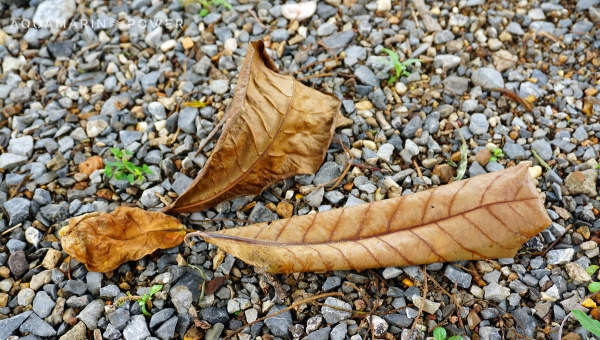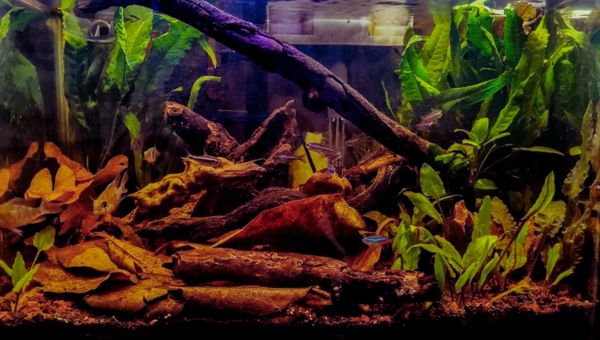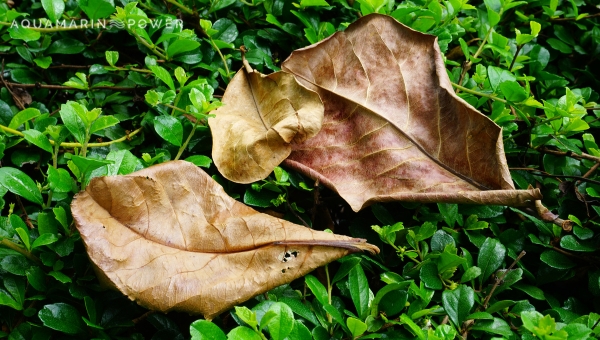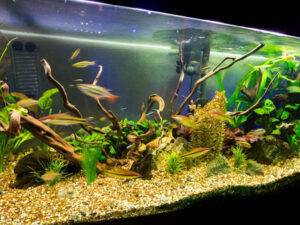Indian almond leaves are known for being used in places where these plants grow naturally. However, there are some other benefits that you may not have heard of until now.
These plants can be bought from aquarium shops, or if you want to use Indian almond leaves that are growing where the plants naturally grow, you’ll have to find a good spot to collect them from.
Indian almond leaves for aquariums keep the water clean and provide a good natural habitat for some fish that survive better in this environment than other options.
Table of Contents
- What Are Indian Almond Leaves?
- Different ways in which they can be included in your aquarium
- Why Indian Almond Leaves?
- Why Do They Change The Colour Of The Water?
- Bringing Indian Almond Leaves Into Your Aquarium Will Make It More Natural
- Is It Possible To Use Too Many?
- What Are The Benefits Of Having Them In Your Tank?
- Provides Decoration to the tank
- Providing Natural Habitat
- Providing Safety For All
- Natural Source Of Food
- Safe to Use
- No Extra Costs
- Environmentally Friendly
- Completely Safe
- An Eco-Friendly Hobby
- Treating Health Issues
- A Natural Antibacterial Agent
- Encourages Spawning
- Helping Shrimp Tanks Thrive
- Breeding Betta Fish
- Keeping The Fish Happy
- Who Will Benefit From This?
- Precautions To Be Kept In Mind
- When To Replace Them?
- Closing Thoughts
What Are Indian Almond Leaves?
The most common type of Indian Almond Leaves you’ll find in shops is from the “Terminalia Catappa“; however, there are many more types of Indian Almond Leaves that can be found. Indian almond leaves are known to keep pH levels in check, which is why they are used by many people worldwide.

Indian Almond leaves provide a great natural habitat for fish living better in this environment than other options. They are also believed to keep the pH levels in check and these leaves can also be used as a fertilizer for other plants.
Aquarium owners who have tried using Indian Almond Leave with their fish claim that these fish grow larger than those who live in tanks without this type of natural habitat. This may be because they provide a more natural environment than the ones these fish would have in a regular tank.
Keeping Indian almond leaves in an aquarium is easy and they typically live for around three months if you want them to survive. However, if you choose not to add Indian Almond Leaves or if you cannot find any you can also use other plants from your garden, as long as they are not poisonous.
Different ways in which they can be included in your aquarium
Submerged Leaves
Use Indian almond leaves in your aquarium by placing them on top of the gravel. These leaves will grow roots if they are submerged underwater and once these roots have grown, you can cut the bottom part of this leaf to let it continue growing.

Once Indian almond leaves are submerged, they will provide the fish with a good place to hide from potential predators. You can also cut them into smaller pieces and use those as a starting point for creating habitats for other types of fish that need a more natural environment to live in.
Floating on the surface
Once Indian almond leaves are submerged, they will provide the fish with a good place to hide from potential predators. You can also cut them into smaller pieces and use those as a starting point for creating habitats for other types of fish that need a more natural environment to live in.
These leaves are known to increase the levels of oxygen available in the tank, which is why many people use them. They will help keep the tank clean and at the same time, they will provide a more natural environment for all fish that live in your aquarium.
Leaf Substrate
Indian almond leaves are known to keep pH levels in check, which is why they are used by many people worldwide. Aquarium owners who have tried using Indian Almond Leave with their fish claim that they grow larger than those living in tanks without this type of natural habitat. This may be because they provide a more natural environment compared to the ones these fish would have in a regular tank.
Some people use this type of leaves as substrate, which means that they place them at the bottom of the aquarium and let them stay there without providing any shelter or hiding places for the fish. Experts do not recommend this; they may need something to hide in.
Once Indian almond leaves are submerged, they will provide the fish a good place to hide from predators. You can also cut them into smaller pieces and use those as a starting point for creating habitats for other types of fish that need a more natural environment to live in.
Indian Almond Tea Leaves
Indian almond tea leaves look very lovely, and they also provide an aerated environment for the fish. You can use them as a decoration but keep in mind that every time you change the water, you need to remove them and clean whatever is left of it.
There are many different ways in which Indian almond leaves can be utilized within your tank, and once they start breaking down they will provide a nutrient-rich environment for other plants that you have.
Compacted Leaves
Another method you can use to add Indian almond leaves to your aquarium is compressing them so they take a more compacted form, which is excellent for decoration.
These leaves are known to increase the levels of oxygen available in the tank, which is why many people use them. They will help keep the tank clean, and at the same time, they will provide a more natural environment for all fish that live in your aquarium.
Why Indian Almond Leaves?

Indian almond leaves work great in providing a natural habitat for fish. They help keep the pH levels in check, and at the same time, they will provide a more natural environment for all types of fish that live in your aquarium.
If you plan on using them, remember not to cut them into too small pieces because this may cause problems regarding water quality, and the fish might be at risk.
You should also consider soaking all of them in fresh water for 12 hours before using them in your aquarium because this will make sure that they don’t rot quickly and create bad bacteria. Indian Almond Leaves are great when it comes to providing natural habitat, but their leaves are known to taint the water
Why Do They Change The Colour Of The Water?
Many people are concerned by the fact that Indian almond leaves change the color of the water. If you have this type of leaves in your aquarium, regularly check the pH levels because these tend to get acidic over time, affecting all fishes.
If you notice that there are changes between what is recommended and what happens, then it is recommended that you take a sample of the water and have it analyzed by professionals. They will be able to provide detailed information regarding your tank’s chemistry and what needs to be done to keep all inhabitants safe and healthy.
Bringing Indian Almond Leaves Into Your Aquarium Will Make It More Natural
Keeping Indian almond leaves in your aquarium will give it a more natural environment, which most experts recommend for every aquarium owner.
To be honest, even though you can purchase all types of plants that work just fine, having Indian almond leaves in the tank provides an opportunity to use nature as a decoration and still have everything under control at the same time.
If you are looking for an alternative item to use, then you should consider getting Indian almond leaves because they are known to keep the fish happy and healthy while at the same time providing them with natural habitat.
If you want your aquarium to be safe for everyone living there, then get rid of any artificial plants or objects because these can get ingested, which will put the fish in danger.
Once the Indian almond leaves start to break down, they will provide a good environment for other plants you have, as well as those being bred. This means that your tank will be more efficient and easier to maintain simultaneously because it provides a natural habitat for all types of fish living there.No matter what type of fish you have in your tank,
Indian almond leaves are the ideal solution when it comes to giving them a natural habitat in which they can live and grow without any issues whatsoever. They also provide something suitable for every type of fish regardless of their age or size.
If you want to own a happy and healthy family of fish, then get Indian almond leaves for your aquarium because they provide a natural environment that is suitable for all.
If you want a safe and healthier habitat for them, as well as a chance to use nature as a decoration without causing any harm to the life in your tank, then this is something that you should consider.
Is It Possible To Use Too Many?
When it comes to Indian almond leaves, you cannot overdo them, so there should be no problems when this is used as a decoration for your aquarium.
The only thing that you should consider is regularly checking the pH levels because they tend to get acidic once the leaves start breaking down and falling apart which could cause issues with other fish in the tank.
If you want to make sure that everyone is safe and healthy within your tank, then make sure to regularly check the pH levels because if it gets too acidic for other fish in the aquarium, they can become sick, which will require a qualified person to take care of them.
So before anything else is added to your aquarium or after Indian almond leaves are broken down, always check the pH levels because they are the most essential thing that you will need to monitor.
If your fish are healthy, then your Indian almond leaves will break down and fall apart within your tank without any issues whatsoever. While at the same time providing a natural habitat for all of them to live in a while keeping the water within safe for everyone.
If you want to own a happy and healthy family of fishes, then make sure they have Indian almond leaves as a decoration in your aquarium because there is nothing else that can compete with nature when it comes to providing a suitable environment for all of them. Ensure regular pH level checks, however, so every fish is always safe and healthy.
What Are The Benefits Of Having Them In Your Tank?
Following are the benefits of having Almond Leaves in your tank.
Provides Decoration to the tank
Since Indian almond leaves look like normal leaves, you can use them to decorate your tank in a natural way that is suitable for all types of fish.
Using Indian almond leaves as a decoration provides an excellent opportunity to take advantage of nature without harming any other life within the aquarium. Also, because they are biodegradable, you can watch them slowly decompose, which will benefit your tank and every fish within it.
Providing Natural Habitat
The Indian almond leaves provide the perfect habitat because they are completely natural and do not cause any problems whatsoever while being eaten or ingested.
Using Indian almond leaves within your aquarium provides a natural habitat for all kinds of fish because they are beneficial to every single one of them, regardless of their size or age. They can also prove to be an excellent source of food in case your fish have started eating the plants that you have in there.
Providing Safety For All
Using Indian almond leaves will provide a secure and safe habitat for every single fish within your aquarium because they do not cause any harm whatsoever.
Using Indian almond leaves as decoration will ensure that all of the fish are completely safe while being in their home because they cannot become ill nor have any injuries while using it. No other decorations you can use offer this level of safety and protection while still looking natural and maintaining a healthy environment.
Natural Source Of Food
Indian almond leaves can be used as an excellent source of food for your fishes because they provide them with everything that they need while also providing decoration to your tank at the same time.
Using Indian almond leaves within your aquarium will provide your fish with all the food they could need because it will be broken down slowly and eventually provide them with greens that are very beneficial for them. They can also act as a natural food source if your fishes start eating the plants you have in your aquarium.
Safe to Use
Compared to other decorations made out of plastic, Indian almond leaves are completely safe because they cannot injure you or your fish in any way.
Using Indian almond leaves will ensure that everyone stays completely safe while in the tank because nothing else in nature can offer such a level of safety and comfort for all kinds of fish and other inhabitants. You also don’t need to use anything else while providing everything your fish needs.
No Extra Costs
Using Indian almond leaves won’t cost you anything because they are completely natural and can be used to decorate your tank while offering all of the benefits listed above.
Using Indian almond leaves within your aquarium will not require you to spend any extra money on them because they do not cost anything to buy and will be used for decoration. You can also use them if your fish start eating the plants you currently have in your tank.
Unlike other decorations that require you to replace them now and then, Indian almond leaves are entirely natural and won’t break down anytime soon, so you won’t have to replace them.
Using Indian almond leaves will allow you not to worry about replacing them with something else because they are completely natural and will not break down anytime soon. This makes it an excellent opportunity for you to decorate your fish tank in a way that is beneficial for every fish without worrying about replacing the decorations now and then.
Environmentally Friendly
Indian almond leaves are completely environmentally friendly because they won’t cause you to spend any extra money on them nor will they harm your fish in any way, making it an excellent addition to your aquarium.
Using Indian almond leaves within your aquarium is beneficial for everyone involved because it will not cause you to spend any extra money nor will it harm your fish in any way while still providing them with everything they need. It is a natural, safe, and environmentally friendly decoration, making it excellent for everyone involved.
Completely Safe
Indian almond leaves are completely safe and won’t cause the inhabitants of your aquarium to experience any injuries or illness while being in the aquarium.
Using Indian almond leaves within your aquarium will ensure that your fish are completely safe while also ensuring that they have everything they need at the same time. There is nothing more you can ask for with regard to decorations which is why it’s an excellent choice for every single tank owner.
An Eco-Friendly Hobby
Indian almond leaves are completely eco-friendly and will not require any of the electricity that you would need to provide for your current decorations, making it an excellent opportunity for those who want to make sure they provide a safe home for their fish as well as one where the environment is taken care of as much as possible.
Using Indian almond leaves is an excellent way for you to provide a safe and comfortable home for your fish while also taking care of the environment for everyone involved. Your tank will no longer require any other decorations because it can provide everything that you need within a single decoration which is why it’s an excellent choice overall.
Treating Health Issues
Using Indian almond leaves will allow you to treat some of the illnesses that your fish tend to experience while also improving their overall health. Treating diseases within your fish tank is an excellent way for you to keep them happy and healthy but it’s also beneficial for yourself because it will provide you with a cleaner environment overall.
Using Indian almond leaves will prevent the disease from spreading and improve the health of your fish, which is why they’re excellent for every single tank.
Using Indian almond leaves within your aquarium will prevent diseases from being spread, which means that everyone will be much healthier as a result. It’s an excellent way to provide a clean environment for your fish as well as yourself because it will keep everyone involved happy overall.
A Natural Antibacterial Agent
Indian almond leaves are completely safe for your aquarium and will not cause any problems while also providing you with an antibacterial agent that can be used to kill many of the bacteria within your tank, making them an excellent addition. Using Indian almond leaves is excellent.
If your fishes start eating the leaves you can place them in a separate tank and feed them to your fishes as needed.
Once the Indian almond leaves start decomposing, they will become part of nature and serve as a food source for all kinds of invertebrates, including those that live inside the aquarium such as snails and crabs. This is why it’s considered to be a completely safe option because it will decompose into a natural substance that won’t cause any harm to the inhabitants of your aquarium.
Encourages Spawning
Indian almond leaves encourage spawning and will allow you to breed your fish which is why they’re an excellent choice for every tank owner. If you want your aquarium to become populated, you need to provide them with everything they need, including the environment that encourages successful breeding.
Using Indian almond leaves within your aquarium will allow you to successfully breed your fish, allowing many different kinds of fish owners to enjoy having their aquariums. There’s nothing more you could ask for when it comes to providing your fish with the right environment, making it an excellent choice overall.
Helping Shrimp Tanks Thrive
Using Indian almond leaves within your shrimp tank is an excellent way to provide them with a much more stable environment while also providing them with all of the things that they need to reproduce and thrive. Unlike other decorations, these leaves don’t require any electricity to power them, making them an excellent option for those who want to provide their invertebrates with safe and natural camouflage.
Using Indian almond leaves within your shrimp tank is an excellent way to ensure that they have a much more stable environment overall, which is why it’s a great choice for everybody involved. They don’t require any electricity to power them, making them excellent decorations for those who want their invertebrate to have a safe and natural environment.
Breeding Betta Fish
Using Indian almond leaves within your betta aquarium is an excellent way to encourage breeding which is why they’re considered to be a necessary decoration for every tank. Once you place these leaves inside of your tank, you can watch as the female betta fish starts using them to lay her eggs.
Once you place Indian almond leaves inside of your betta aquarium, the female will use them to lay their eggs, which is why they’re considered to be an excellent decoration for every single tank owner. Not only are they good for all kinds of fish, but they can also provide you with hours of entertainment once your fish start breeding.
Keeping The Fish Happy
As mentioned earlier Indian almond leaves are known to keep the fish happy and healthy while at the same time providing them with a natural habitat that is safe for everyone that lives there. If you want your aquarium to be more efficient, then ensure that any artificial objects are removed because they can get ingested by other fish within your tank, which can cause issues.
Who Will Benefit From This?
Indian almond leaves are beneficial for every fish within your tank, regardless of their age or where they come from. Nothing else can compete with nature when it comes to providing an ideal habitat for everyone who lives there since Indian almond leaves provide the perfect environment for all types of fish to live and grow within.
If you want to provide a natural habitat for your fish, then make sure they have Indian almond leaves as a decoration because this will be beneficial for everyone who lives there without causing any issues whatsoever.
Although always ensure regular pH level checks to ensure that every fish is safe and healthy at all times, which is very important.
Precautions To Be Kept In Mind
- Always make sure that the Indian almond leaves you choose are intended for aquariums because there’s a difference between these and regular ones.
- You should also know that most fish won’t eat Indian almond leaves, which is why they’re excellent decorations in every tank.
- If you have an invertebrate in your aquarium, ensure that the leaves aren’t sharp and can cut them, which will cause severe damage.
- The Indian almond leaves you purchase should also be free of pesticides, chemicals, or other substances that might harm your fish.
- If you’re unsure about anything, then always take the necessary precautions before introducing the leaves into your aquarium because they’re known to react badly with certain substrates and need to be kept away from filters, pumps, and heating devices.
- Regularly check the Indian almond leaves within your tank because they can start to rot if left in stagnant water for too long. This is why you must replace them when needed.
- Always make sure that the Indian almond leaves are kept out of reach from your pets because they can become a choking hazard.
- If you have any other pets that might be interested in eating these leaves then place them somewhere where they can’t reach them. Otherwise, it will end up causing serious damage to their internal organs.
- Digestive issues are also something you should be aware of to prevent anything from getting inside of your fish’s stomach.
- Don’t use Indian almond leaves that have been exposed to pesticides, chemicals, fertilizers, or any other substances which might cause harm to the other living creatures within your tank.
- If there are any worms or insects on the leaves, then be sure to remove them or keep the aquarium away from other pets which might try and eat them.
- If your leaves start rotting within your tank because they’ve been left stagnant for too long, then you’ll need to replace them as soon as possible because this can cause damage to both your fish’s health and well-being.
When To Replace Them?
Although Indian almond leaves can last indefinitely, there’s a small chance that they might start to rot, so you should regularly check them. You should also be aware that if the water conditions aren’t optimal, then this will cause them to rot at a faster rate than usual, so ensure that the pH levels are correct and the tank is clean to prevent this.
The Indian almond leaves can vary in size so if you have larger tanks, then you should pick ones that are smaller so they’ll fit nicely without causing any issues whatsoever. Also, remember that some of them might get eaten by your fish, which is why replacing them when needed is important because losing one or two leaves isn’t a big deal.
It’s also recommended that you remove the leaves from your tank when you’re doing any tank maintenance, even if it’s just a partial water change because this will prevent them from being disturbed in any way possible.
You can safely place them back after everything is finished and you’ve checked to ensure no leaks within your aquarium.
Be careful when you’re deciding where to place the leaves as well because they can fall into any openings within your tank and this will cause a major problem. So make sure that you leave some space between them for easy removal or they can get stuck if they roll up against something.
It’s recommended to replace the Indian almond leaves every two weeks as this will ensure that your tank is kept as natural as possible, and if you don’t want to replace them, clean them regularly. This might be difficult at first, so it’s best to quarantine some of the leaves and see how they react with any medications you’re using within their tank before placing them back into the main aquarium.
If you have any algae or moss within your tank, then you should avoid having Indian almond leaves because they’re known to eat most types of plants which can cause major damage to your entire tank if they’re not removed immediately.
Closing Thoughts
It’s worth mentioning that there’s a possibility that Indian almond leaves might cause your tank to go through a mini-cycle because algae and bacteria can grow on them if they’re not kept clean, so it’s recommended to place them in quarantine for about two weeks alongside any medications you plan to use before placing them back into the aquarium once everything is complete.
If you take proper care of your Indian almond leaves, then you shouldn’t have any problems but keep in mind that there’s a chance that they might start to rot if their conditions aren’t optimal, so it’s important to pay attention to them.
If you’re unsure about anything, then it’s best to ask an expert for more information, and if you have any other questions, then feel free to ask below.
We’re very grateful to everyone who took the time to read this article, and we hope that you’ve learned something new today!



